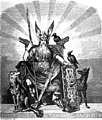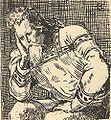Seeding
Saming ( Norwegian Sæming , Old Norse Sæmingr ) was a legendary ancestor of Norwegian kings who lived in the 3rd century a. Z. should have ruled.
According to the Icelandic poet Snorri Sturluson , Säming is said to have been a son of Odin with the beautiful giant daughter Skadi . Odin made him ruler in today's Norway. Saming has therefore become the progenitor of the little kings of Hålogaland and Trøndelag and Nor (d) land . Thránd (Þrándr), referred to in some traditions as a son of Saming, is considered to be the mythical founder of Trondheim . The Trondheim Ladejarle also claimed a descent from Säming.
The poet Snorri created the legend of Säming.
Odin , the father of the gods , was said to be Seeding's father.
The giantess Skadi was considered the mother of Seeding.
Håkon Jarl saw himself as a descendant of Seeding.
According to one tradition, Odin himself moved from Sigtuna in Sweden over the snow-covered and icy Scandinavian mountains to the northwest (Norway), according to the other tradition he sent his son Säming out. Säming, who was described as a good skier and ice skater as well as a skilled hunter and brave warrior, subjugated the mountain people of Trøndelag and Hålogaland and established a rule that he later divided between his sons, with Godhialt receiving Hålogaland and Thránd Trøndelag. In the Háleygja valley of the Edda , Säming was not referred to as the son of Odin, but as the son of Yngvis (and the kings of Hålogaland saw themselves in this lineage). Other sources referred to Thránd not as a son of Saming, but a son of Nór.
The Germanist Karl Müllenhoff and the literary historian Richard M. Meyer described Säming as a representative of the Finnish-Sami indigenous population in the North Germanic religion and established a connection between Säming and the Sami indigenous population of Scandinavia. The Scandinavian Jurij Kusmenko also thought it possible that Säming could mean "the one descended from Sami".
Individual evidence
- ^ Wilhelm Wägner : Our prehistory , Volume 1 (Germanic legends of the gods). Neufeld and Henius Verlag, Berlin 1922, p. 256.
- ^ A b Ludwig Albrecht Gebhardi : History of the Kingdoms of Denmark and Norway , Volume 1. Gebauer, Halle 1770, p. 42 f.
- ^ Christian Blangstrup: Säming . In: Johannes Brøndum-Nielsen, Palle Raunkjær (ed.): Salmonsens Konversationsleksikon . 2nd Edition. tape 22 : Speculation – Søøre . JH Schultz Forlag, Copenhagen 1927, p. 957 (Danish, runeberg.org ).
- ^ Arvid August Afzelius : Folk sagas and folk songs from Sweden's earlier and more recent times , part 1. Kollmann, Leipzig 1842, p. 92 f.
- ↑ Ludwig Albrecht Gebhardi : The general world history . Volume 13, p. 165 f. Gebauer, Halle 1774
- ^ Heinrich Beck, Wilhelm Heizmann, Jan van Nahl: Snorri Sturluson - historian, poet, politician . Pp. 208 and 212. Gruyter, Berlin 2011
- ^ Richard M. Meyer : Old Germanic history of religion . Severus Verlag, Hamburg 2013, p. 211
- ↑ Jurij Kusmenko : Representation of the seeds in the Old West Scandinavian literature . (PDF) Berlin 2011, p. 2
- ↑ Jurij Kusmenko : Notes in Scandinavian mythology . (PDF) Berlin 2011, pp. 30–33



